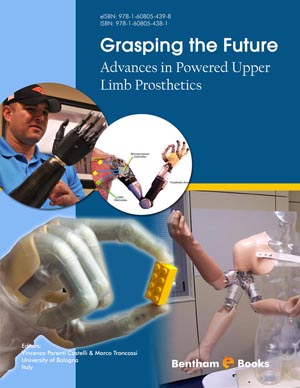Abstract
After introductory considerations on the main functional and design differences between anthropomorphic hands conceived as robotic end effectors or as prostheses, this chapter presents two topics related to advances in robotic hand design that seem transferable to prosthetic hands, in order to increase their functional capability yet coping with specific constraints like simplicity, lightweight, cost effectiveness, robustness, etc. The development of a bio-inspired robotic hand, called UB Hand IV, based on an endoskeletal articulated structure, actuated by tendons and covered by a soft dermal-epidermal layer is briefly illustrated, in order to show the potential of its design solutions to be transferred into prosthetic hands. The first part of the chapter presents alternative design approaches for articulated joints and finger structures based on purposely designed compliant hinges. The basic problem of compliant hinges adoption in robotic structures, that is the limitation of secondary compliance effects, is analyzed and considerations about comparative metrics are proposed. Two hinge morphologies which show promising features are critically compared and pros and cons the production of fully integral fingers with compliant joints are discussed. The second part reports on the development of thin soft covers for robotic (and prosthetic) hands capable of strictly mimicking the actual compliance of human finger pulps. A design method, called by the authors Differentiated Layer Design (DLD), is reviewed and its potential for application on both robotic and prosthetic devices is underlined. Conclusions summarize the main aspects that encourage the transfer of the described results from the world of robots to that of human portable devices.
Keywords: Robotic/Prosthetic Hands, Large Displacement Compliant Joints, Soft Fingertips, Design Methods, Performance Indexes






















